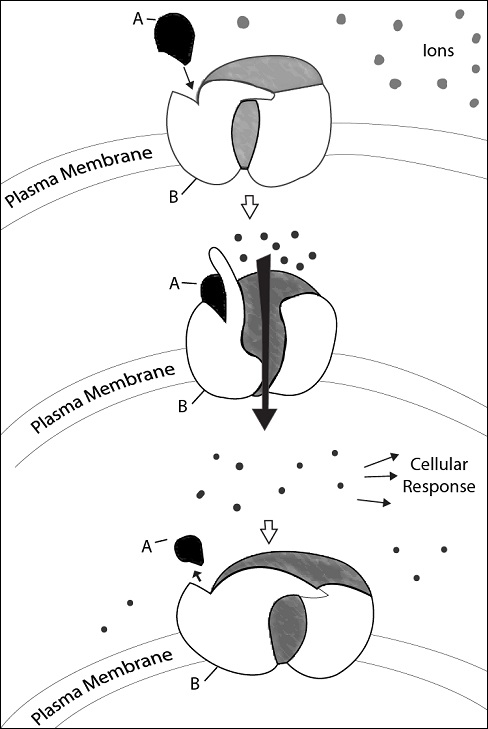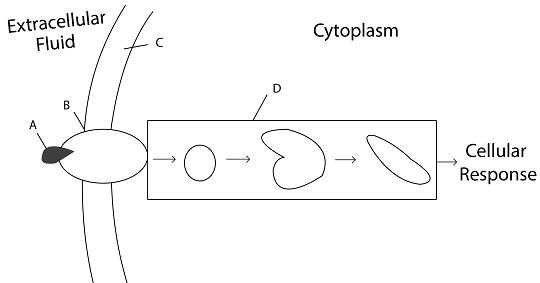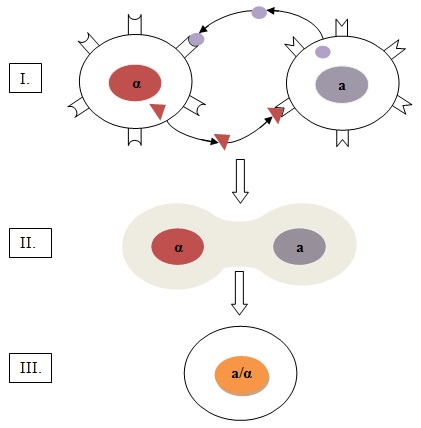Congratulations - you have completed .
You scored %%SCORE%% out of %%TOTAL%%.
Your performance has been rated as %%RATING%%
Your answers are highlighted below.
Question 1 |
Identify the correct sequence of cell signaling.
Activation of cellular response, Reception, Transduction | |
Transduction, Reception, Activation of cellular response | |
Reception, Transduction, Activation of cellular response | |
Reception, Activation of cellular response, Transduction |
Question 1 Explanation:
The correct answer is (C). Reception occurs first, when the target cell detects a signaling molecule coming from outside the cell. Next, transduction takes place with the binding of the signaling molecule changing the shape of the receptor protein and initiating the process of transduction. Transduction converts the signal to a form that can bring about a specific cellular response. Finally, the activation of cellular response takes place when the transduced signal triggers a specific cellular response.
Question 2 |
Use the diagram below to answer questions 2–4

Which type of membrane receptor (B) is represented in the diagram?
Receptor Tyrosine Kinase | |
Ligand-Gated Ion Channel Receptor | |
G Protein-Coupled Receptor | |
Phosphorylation Cascade |
Question 2 Explanation:
The correct answer is (B). The diagram shows a ligand-gated ion channel receptor with a region that acts as a gate when the receptor changes shape. When the signaling molecule (A) binds to the receptor protein (B), the gate opens and allows ions to flow through to the plasma membrane through the channel receptor.
Question 3 |
Use the diagram below to answer questions 2–4

What is Part 2 of the diagram showing?
The channel receptor with a closed gate waiting for the signaling molecule to bind to the receptor | |
The dissociation of the receptor from the receptor protein, allowing the gate to close and prohibiting ions from entering | |
The signaling molecule binding to the receptor, allowing the gate to open for ions to flow through the channel | |
A hormone passing through the plasma membrane via a G protein-coupled receptor |
Question 3 Explanation:
The correct answer is (C). Part 2 the diagram is depicting the action of the signaling molecule binding to the receptor and allowing the gate to open. Specific ions then flow through the channel into the cell.
Question 4 |
Use the diagram below to answer questions 2–4

What type of molecule is represented by A in the diagram?
Hormone | |
Signaling molecule | |
Receptor protein | |
Active protein |
Question 4 Explanation:
The correct answer is (B). Signaling molecules are molecules that have a specific shape to “fit” in a portion of the receptor protein, like a key fitting into a lock. The signaling molecule causes the receptor protein to change its shape that directly activates the receptor.
Question 5 |
Yeast and mammals share very similar cell communication molecules and pathways. What does this suggest about yeast and mammals?
Yeast and mammals share a recent common ancestor | |
Early versions of cell communication mechanisms still used today must have evolved before the first multicellular organisms | |
Signaling molecules first evolved in multicellular eukaryotes | |
All cell communication systems are used for sexual reproduction |
Question 5 Explanation:
The correct answer is (B). Even though the last common ancestor of yeast and mammals lived over a billion years ago, the molecular details of signal transduction in yeast and mammals is very similar.
Question 6 |
Which of the following is an example of long-distance cell signaling?
Cell-cell recognition in animal cells | |
Synaptic signaling in the nervous system | |
Hormonal signaling in humans | |
Plasmodesmata in plant cells |
Question 6 Explanation:
The correct answer is (C). Cell-cell recognition involves direct contact between cells. Synaptic signaling requires the nerve cell to be very close to the target cell. Plasmodesmata in plant cells is a junction that allows molecules to pass between adjacent cells with out having to cross the plasma membrane. Hormones are used by plants and animals for long-distance signaling.
Question 7 |
Questions 7–9: Use the diagram below to identify the activity or object in the pathway.

Which letter represents the plasma membrane of the cell?
A | |
B | |
C | |
D |
Question 7 Explanation:
The correct answer is (C). The plasma membrane is the selectively permeable layer of molecules that encloses the cell.
Question 8 |
Questions 7–9: Use the diagram below to identify the activity or object in the pathway.

Which letter represents a signaling molecule coming from outside the cell?
A | |
B | |
C | |
D |
Question 8 Explanation:
The correct answer is (A). The receptor protein detects the signaling molecule when the signaling molecule fits into the receptor. This is known as “reception.”
Question 9 |
Questions 7–9: Use the diagram below to identify the activity or object in the pathway.

Which letter represents the conversion of the signal to a form that brings about a cellular response?
A | |
B | |
C | |
D |
Question 9 Explanation:
The correct answer is (D). Signal transduction pathways are a sequence of changes in a series of molecules, that allows information to trigger a cellular response.
Question 10 |
Use the diagram below to answer questions 10–11. The diagram shows two yeast cells (Saccharomyces cerevisiae) using cell communication for a biological process.

What is illustrated in Part I?
Cells of type a secrete a signaling factor called a which can bind to nearby receptors on α cells | |
Cells of type α use phagocytosis to absorb molecules called a | |
Cells of type a and α are communicating within a multicellular organism to bring about a cellular change | |
Two single celled prokaryotic cells are undergoing asexual reproduction |
Question 10 Explanation:
The correct answer is (A). Part I shows type a cell secreting factor a which binds to a receptor site on type α cell. Inversely, type α cell is secreting factor α which binds to a receptor site on type a cell.
Question 11 |
Use the diagram below to answer questions 10–11. The diagram shows two yeast cells (Saccharomyces cerevisiae) using cell communication for a biological process.

What biological process is taking place in the diagram?
Fermentation | |
Budding | |
Signal transduction pathway | |
Zygote formation |
Question 11 Explanation:
The correct answer is (D). The binding of the factors to the receptors leads to the fusion of the two cells. The nucleus of the fused cell, a zygote, includes all the genetic information from type a cell and type α cell. This zygote can then undergo mitosis leading to the formation of a diploid bud.
Question 12 |
During which process do cells enter into programmed cell death, during which time DNA is chopped up, organelles are fragmented, the cell shrinks and parts of the cell are packaged into vesicle and removed by scavenger cells?
Apoptosis | |
Catastrophism | |
Cytokinesis | |
Endocytosis |
Question 12 Explanation:
The correct answer is (A). Aptosis is controlled suicide of the cell. Catastrophism is the idea that events in the past occurred suddenly and were caused by different mechanisms than those operating today. Cytokinesis is the division of the cytoplasm to form daughter cells after mitosis. Endocytosis is process by which materials enter the cell via the formation of vesicles.
Once you are finished, click the button below. Any items you have not completed will be marked incorrect.
There are 12 questions to complete.
|
List |
Next Practice Test:
Transmission of Information >>
AP Biology Main Menu >>
